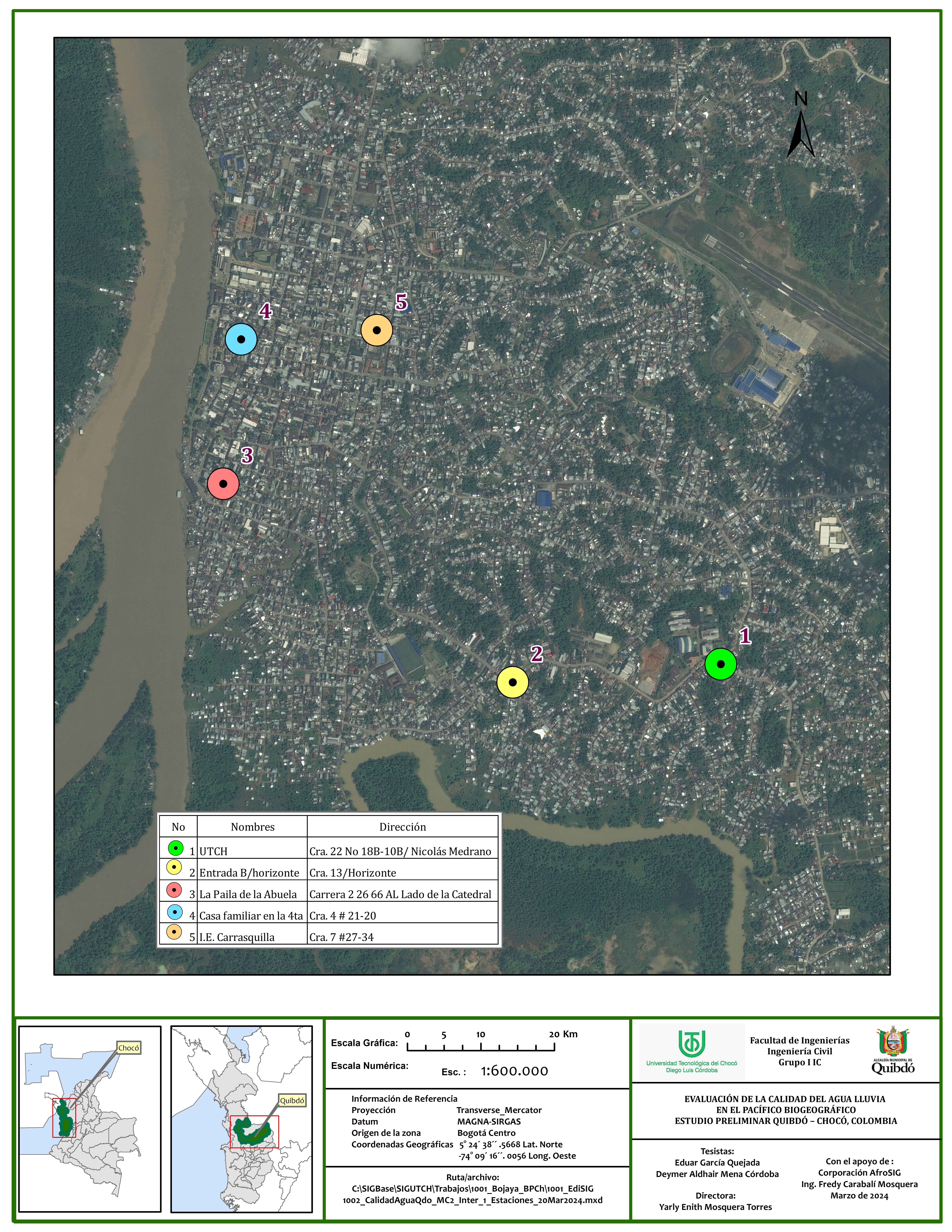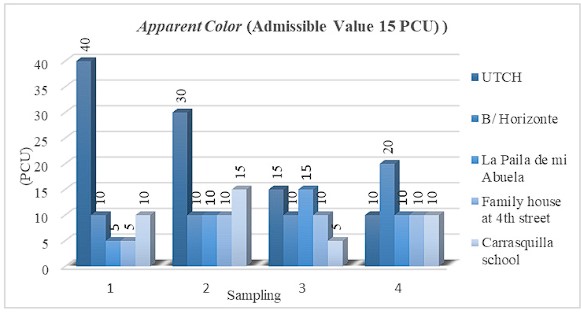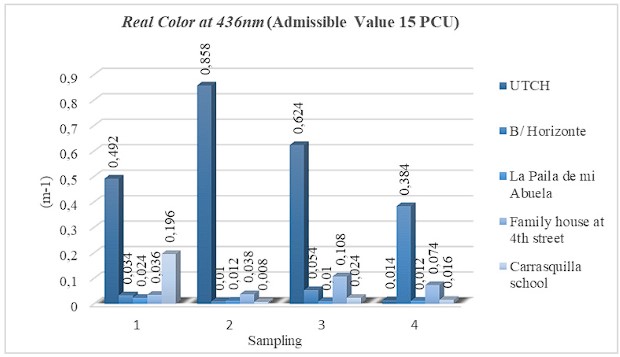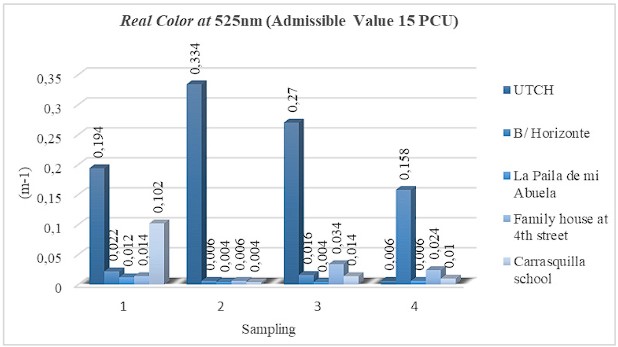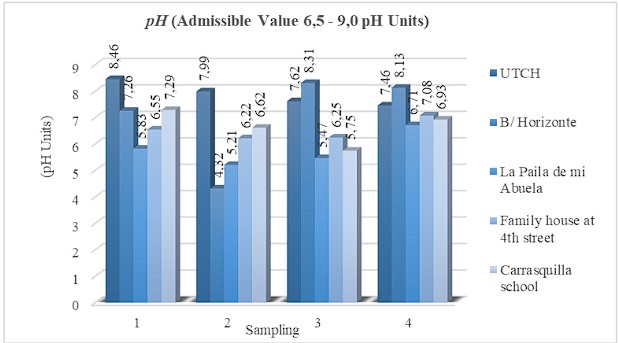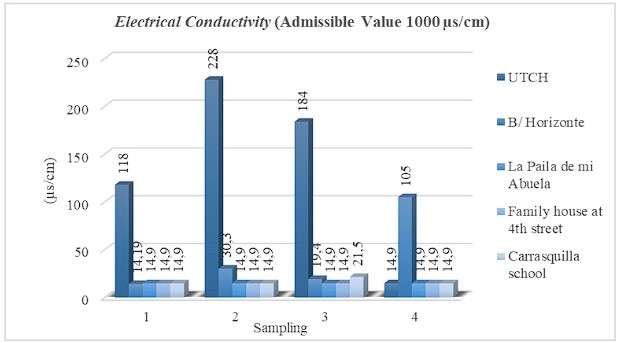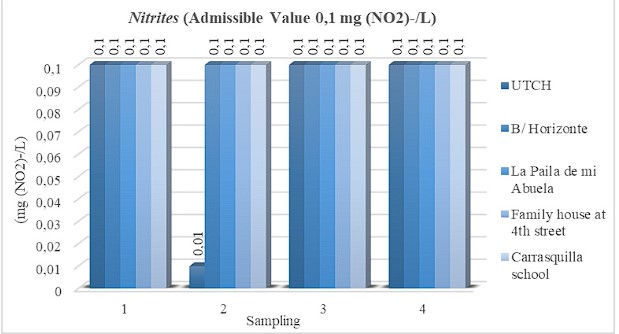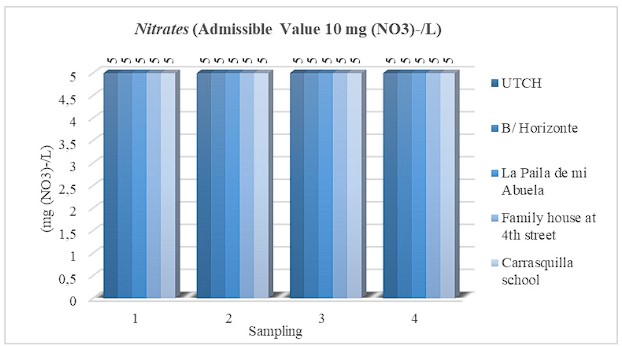Introduction
Since ancient times, humans have had the need for water supplies. Water is essential for the life of every living being, and plays an important role as it is a useful and indispensable element for carrying out personal activities and those inherent to the social and economic development of humanity, who throughout history have used different supply sources, including surface, underground and rainwater. Around the world and at different times of humanity, rainwater has been used for human consumption 1.
In Africa, since 1970, campaigns have been carried out to recover ancestral traditions of rainwater harvesting to supply rural communities using the Fanya juus technique 2. This technique consists of the development of terraces which are built to form a dike 3-4. Buildings in England and Germany use rainwater to flush bathrooms and in firefighting systems. While in the United Kingdom, rainwater harvesting has been an alternative technique to supply quality water for human consumption 2-3) (5) .
In the city of Vancouver (Canada), a subsidy is provided for the purchase of plastic tanks to collect rainwater from roofs, which is then used to water gardens 2. In some states in the United States, legislation has been created requiring stormwater management 2. In Latin America, mainly in rural areas of South and Central America, as well as in the Caribbean, rainwater harvesting systems have been installed for domestic use as a solution for water supply. Basically, these systems consist of placing gutters around the roofs of homes which are connected to collection pipes and subsequently deposited in cisterns or tanks2.
In Colombia there are companies that have incorporated technologies in relation to sustainable development that save water, through the use of rainwater, which is subjected to purification processes for human consumption and/or treated for production processes 6. In rural areas it becomes a highly used alternative 7.
Regarding the department of Chocó, it is considered one of the rainiest places in the world with a great biodiversity. Precipitation in this territory ranges between 1500mm/year and 8500mm/year 8-9 and the Quibdó station of the National Isotopy Network (RNI) has the highest value of 20.91% at the intercept of the local meteoric quantity rain line 10. However, this situation is in contrast to the figures from the National Planning Department (DNP) where it is evident that only 28.5% of the population has aqueduct coverage, while the rest of Colombia has 74.4%. These data reflect a low index and make it the department with least access to drinking water in the country 11. This water supply alternative is one of the most used in this department and despite not having studies that guarantee its quality, this resource is used to develop agricultural and domestic activities 12-13.
Rainwater is an easy resource to obtain and depending on the area in which it is located, it is relatively clean, free of chemical residues such as chlorine and lime, it does not come into contact with the soil or the rocks where salts and minerals dissolve and has profitable production, especially today, when water resources are increasingly more expensive 14-16. In addition to the above, storage of rainwater allows mitigation of flood risks 17. However, its physicochemical and microbiological characteristics must be evaluated to determine its viability for human consumption .
According to the World Meteorological Organization (WMO) 18, rainwater is the amount of precipitation of liquid water particles with a diameter greater than 0.5mm that fall over a specific area. Likewise, precipitation can be defined as the liquid or solid elements from the condensation or sublimation of water vapor that fall from the clouds or are deposited from the air on the ground 19. According to the National Water Study (ENA for its acronym in Spanish) 8 the percentage of precipitation for Colombia in a future scenario (year 2070) will remain in the Pacific region, where the study area is located. Therefore, residents could be guaranteed drinking water solutions in their homes to the extent that studies are carried out to determine its quality and possible treatment 20, which would also help to comply with Sustainable Development Objective No .6 (Clean Water and Sanitation) or could be used for non-potable purposes 11.
In this research, the physicochemical and microbiological quality of rainwater in the city of Quibdó, Chocó, Colombia is evaluated, in order to identify possible contamination factors and/or parameters according to established sampling points 21. In addition, possible uses that residents can give it are determined according to Decree 2115 of 2007, after identifying factors and/or quality parameters 22.
The sites of interest established in this research are Universidad Tecnológica del Chocó (University), an educational institution and a restaurant, which are places visited by many people. Therefore, it is necessary to know if the rainwater used in these sites can be used for human consumption as an alternative method, due to poor aqueduct coverage. Sampling in a neighborhood of the capital of Chocó (Horizon) and a single-family home is also taken into account, with the objective of having information on areas of different socioeconomic levels. Furthermore, when identifying the sampling points and the activity, we seek to cover the largest possible area between the sites of interest. Sampling points are strategically located to ensure they are representative samples.
This article is organized as follows: Section 2 describes the materials and methods used in this research. Section 3 shows the results obtained and the discussions. Finally, the conclusions are presented in section 4.
Materials and Methods
Study Area
Quibdó (see Figure 1) is the capital of the department of Chocó. Its climate is tropical humid, corresponding to the climate of the Pacific biogeographic region, located on the right bank of the Atrato River at 43 meters above sea level. It has an area of 3,075 Km2 and a population of 133,906 inhabitants, 84.91% of its population is black and its total income per capita is COP$ 1,112,119. Allocation of the General Royalties System for the drinking water sector with a cut-off for the year 2020 was 2.73%, despite the fact that the aqueduct coverage is only 25.2% 23.
Rain Intensity in the Study Area
According to the ENA 8, when observing the national map of average annual and monthly multi-annual runoff of Colombia, the highest precipitation values are presented in the Pacific region. The subzone with the highest runoff corresponds to the Andágueda River, precisely in the Atrato hydrographic zone, with 8,307 mm/year. Additionally, the change in precipitation for Colombia in a future scenario (2070) indicates that precipitation conditions will be maintained in this area, therefore, it is forecast that the intensity of rain in the city of Quibdó will continue for a long period time 8. The foregoing confirms that Quibdó has high surpluses of rainwater 19.
Sampling
Rainwater harvesting was carried out during a period of two months starting in September 2022, avoiding contamination by foreign substances as much as possible and taking into account the procedure described by the Geographic Institute Agustín Codazzi 24 and other current regulations 25. Samples were collected using plastic surfaces connected directly to 400 milliliter plastic gallons, which were sent to certified laboratories for evaluation.
Quality Control
In order to guarantee the unaltered quality of harvested rainwater, the specifications of the Aburrá Valley Surface Water Monitoring Manual were followed 25, in order to guarantee unaltered quality of the rainwater harvested for subsequent physicochemical analysis.
Selection of Strategic Points
20 fixed sampling points were established (see Figure 2), using homes that had roofs built of zinc, mantle and asbestos cement, because this type of material is used in the municipality of Quibdó. Additionally, a high vehicular and pedestrian flow was taken into account.
Measured Parameters
According to Resolution 2115 of 2007, issued by the Ministry of Social Protection and the Ministry of Environment, Housing and Territorial Development of Colombia, the physical parameters that were analyzed in the samples collected to evaluate their viability for human consumption are: apparent color and real color. In relation to the chemical parameters, conductivity, pH, total alkalinity, nitrites and nitrates were evaluated. On the other hand, the microbiological parameters evaluated were total coliforms and Escherichia Coli22. Table 1 shows the units of measurement and the method used for their evaluation.
Table 1 Parameters evaluated, units of measurement and method used
| Parameter | Unit | Method |
|---|---|---|
| Apparent color | Platinum Cobalt Units (PCU) | Spectrophotometric |
| Real color | Platinum Cobalt Units (PCU) | Spectrophotometric |
| Total alkalinity | mg of CaCO3/L | Titrimetric |
| Conductivity | micro siemens/cm | Refractometer |
| Total coliforms | CFU/100 mL | Multiple tubes (Fluorocult, lauryl sulfate broth; Incubation for 48 hours at 35°C |
| Escherichia Coli | CFU/100 mL | Multiple tubes (Fluorocult, lauryl sulfate broth; Incubation for 48 hours at 35°C |
| Nitrates | mg of (NO3)-/L | Photometric by Merck kit |
| Nitrites | mg of NO2-/L | Photometric by Merck kit |
| pH | Units of pH | Electrometric |
Results and Discussion
Descriptive Statistical Analysis
A descriptive statistical analysis was used to compare the results of the 20 samples and carry out an assessment leading to the determination of rainwater quality in the city of Quibdó 26-28.
In the microbiological analysis, the presence of colony-forming units of Escherichia Coli and total coliforms was found in 100% of the representative samples, which indicates based on the current standards, that the water is not suitable for human consumption because Resolution 2115 of 2007 establishes that the acceptable admissible value is 0 CFU/100 mL, meaning that no water used for human consumption should contain E. Coli or total Coliforms 22. See Figures 3 and 4.
In the physical analysis, 15% of the samples regarding the apparent color parameter do not meet the admissible value (15 PCU), this could have been caused by slight droughts between the sampling periods. See Figures 5, 6, 7 and 8.
When performing the chemical analysis, 34% of the samples do not comply with the pH parameter since it is below the minimum admissible value, which ranges between 6.5 and 9.0 pH units. The results obtained in the analyzes indicate that the water is acidic, see Figure 9.
In relation to the parameters of alkalinity (200 mg CaCO3/L), electrical conductivity (1000 µs/cm), nitrites (0.1 mg (NO2)-/L) and nitrates (10 mg (NO3)-/L) it is observed that they are within the admissible values, according to Resolution 2115 of 2007. See Figures 10, 11, 12 and 13.
With the values obtained, an extrapolation was made on a map with a physicochemical spectrum, which shows the results of the apparent color (AC) of sampling 1. In this map, it can be seen that points 2, 3, 4, and 5 are shaded with a green color, which means that they comply with the maximum acceptable values whose regulatory range is 15 PCU. However, point 1 of samples 1683WEO1 and 1749WEO1 are above the acceptable value since according to the results they have 40 and 30 PCU respectively, therefore, this parameter in these samples is not admissible. See Figure 14.
In addition, Figure 15 (map with a microbiological spectrum) shows the sampling results of the Escherichia Coli (EC) parameter. According to Figures 3 and 4, none of the points meet the values established for this parameter, which must be 0 CFU/100 mL. Points 1 and 4 have a higher intensity, meaning they have higher levels of Escherichia Coli compared to points 2, 3 and 5. This suggests that points 1 and 4 present a greater health risk and require immediate intervention.
Discussion
The results show that the pH of samples 1683WEO2, 1647WEO3, 1683WEO3, 1749WEO3, 1683WEO4, 1749WEO4 and 1749WEO5 is below the acceptable limit, indicating that the water is acidic. This may have been caused by the weather and atmospheric conditions at the time it was collected. It is observed that the apparent color does not comply with the allowed limits at points 1647WEO1, 1683WEO1 and 1814WEO2, which could be caused by slight droughts during the time of collecting the samples, the time and place in which the collection was carried out. In a study carried out in Guangzhou, South China, the research results showed pH values below the permissible range 29.
By analyzing the results obtained in the laboratory, it was possible to determine the physicochemical and microbiological quality of the water collected in the homes located in the downtown area and Medrano neighborhood of Quibdó - Chocó. When evaluating these results, it was analyzed that the water is not suitable for human consumption because it does not comply with the parameters established in Joint Resolution 2115 of June 22, 2007, issued by the Ministry of Social Protection and the Ministry of Environment, Housing and Territorial Development, which establishes the characteristics, basic tools and frequencies of the control and surveillance system for the quality of water intended for human consumption.
According to paragraph 2 of said Resolution, no water sample intended for human consumption must contain E. Coli in a volume of 100 mL of water, regardless of the analysis method used. Based on this premise, none of the samples analyzed meet the microbiological parameter, since they present colony- forming units (CFU) due to external factors such as plants, animals, rodents, etc., which, when established on roofs, leave these bacteria that are harmful to health. Similarly, a study conducted on tank water samples collected in urban and peri-urban areas in southeastern Queensland (Australia) found contamination of rainwater caused by bird fecal material 30.
According to the parameters evaluated, it is observed that the color, electrical conductivity, nitrites and nitrates are within the limits allowed by Resolution 2115 of June 2007. The results for nitrites did not exceed the value of 0.1 ( mg (NO2)-/L), nitrates did not exceed the value of 10 (mg (NO3)-/L) and electrical conductivity did not exceed 1000 (µs/cm).
The University of Toulouse in France conducted a study called “Roof Runoff Water Quality Monitoring: Interpretation by Multivariate Analysis,” which revealed the simultaneous presence of Escherichia Coli and Enterococci in the collected water samples. This study highlights the importance of evaluating the quality of water in any location before consumption, to determine the necessary measures that should be taken before using it 31. When comparing said study with this research, both texts highlight the importance of evaluating the quality of water before consumption, and of following the standards and regulations established to guarantee safety of water for consumption.
Similarly, a study carried out at the Faculty of Engineering of the Islamic University of Malaysia concluded that water harvested from precipitation is not suitable for human consumption, but it is suitable for use in gardens, rinsing or cleaning 32. In the city of Kleinmond (Western Cape, South Africa) studies were carried out to determine the quality of rainwater, which showed the presence of total coliforms in ranges higher than those allowed for drinking water 33. Likewise, a study carried out in Austin, Texas, suggests that before using water for human consumption, treatments should be carried out to eliminate its microbial diversity 34.
In a study carried out at Institución Universitaria Colegio Mayor de Antioquia, the presence of total Coliforms and Escherichia Coli was found, which originate mainly from feces of different animals (birds, rodents, felines, etc.) that can be deposited on roofs and gutters of buildings 35. Similarly, in a study carried out in the city of Ibagué (Tolima) 21 and in Los Lagos (Buenaventura) 36, the presence of total coliforms was detected. Therefore, by containing these microbiological agents, the water is not suitable for human consumption as established by Resolution 2115 of June 2007.
The results of this study indicate that rainwater in the downtown area and Medrano neighborhood of the city of Quibdó - Chocó can have some uses, such as irrigating crops and domestic cleaning, but it is not suitable for human consumption, without prior treatment. The pH, apparent color and real color values indicate that the rainwater in Quibdó is relatively clean, but the presence of Escherichia Coli and total Coliforms suggests that it is contaminated with organic matter and bacteria of fecal origin .
The use of rainwater for human consumption requires adequate treatment, whether through physical, chemical or biological processes, to guarantee its quality and safety. In this sense, it is necessary to implement strategies and public policies that promote harvesting and adequate treatment of rainwater, in order to take advantage of this resource in a sustainable manner and contribute to the conservation of freshwater in the region.
In addition, it is necessary to continue monitoring the quality of rainwater in Quibdó and other regions, to identify possible changes in its composition and take preventive measures if contaminants or significant alterations are detected. In this sense, it is important to involve the community in the monitoring and care of rainwater, in order to promote a culture of conservation and responsible use of this vital resource.
Conclusions
In this research, which was carried out with a series of limited data, it was determined that the rainwater harvested in different selected points has components that alter its physicochemical and microbiological qualities, such as apparent color, total coliforms, pH and Escherichia Coli.
From the results obtained, it is deduced that water with the presence of Coliforms is not suitable for human consumption. In addition, there is presence of harmful bacteria, such as Escherichia Coli, which can cause gastrointestinal diseases. Using water contaminated with Coliforms for bathing can increase the risk of skin or urinary tract infections, and can be especially dangerous for people with weakened immune systems. The Universidad Tecnológica del Chocó (UTCH) and the Carrasquilla Industrial Education Institution use these waters for purposes that do not require high quality standards, such as irrigation, cleaning, washing, and emptying sanitary batteries, with the aim of meeting their water demands and consumption.
In the evaluation of the physicochemical and microbiological quality of rainwater harvested in buildings of the downtown area and Medrano neighborhood of the city of Quibdó - Chocó, it was evident that the water is not suitable for human consumption, due to the fact that the physicochemical and microbiological analysis of the parameters stipulated in Resolution 2115 of June 2007, are outside the range.
Taking into account that rainwater is not suitable for human consumption, it is recommended that the community in general refrain from consuming rainwater without carrying out any purification or treatment process; and it is also recommended that future researchers expand studies to other areas that include the design of rainwater supply systems with their respective treatment system. Among the options to be used as corresponding treatment measures are: heating, chlorination, ozonation, ceramic filters, ultraviolet, hydrochloric acid (HCl), calcium carbonate, sand filters, activated carbon, sheets, among others.
The importance of rainwater is worth highlighting, and it should not be considered as waste, but as a resource, and consequently be incorporated into the management of water resources in the country, through an Integrated Rainwater Management (IRM) policy. On the other hand, good rainwater management contributes to reducing flood levels in cities.















